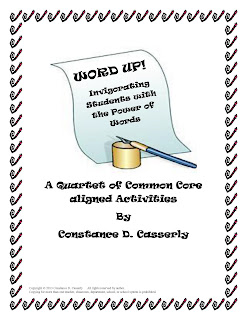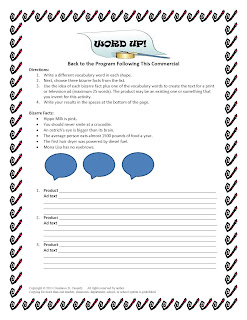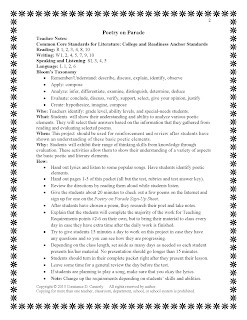Lesson-Up Express: Making the Most of May: doesn't sound like a very positive title, does it? Oh, but it is. Let me explain. Unless it has changed since I left the classroom two years ago, and I hear that it hasn't, the merry month of May is more often than not a miserable morass with very little continuity for teachers and their students. Why? Simply put-TESTING. The first fifteen days of the month are set aside for nation-wide Advanced Placement testing, and the last two weeks, with seepage into June, students sit for the state standardized tests.
Even though I taught regular English 12 classes, many of my students took 3-5 other A.P. classes, but had chosen regular English for their final year in high school. That meant that for those first two weeks, I could have anywhere from nine to twelve or so students absent while they took A.P.exams in any academic area, and not just in my English classes. My creative writing and Journalism classes, all with students from 9th to 12th graders, were equally affected because so many of the seniors in these classes opted for a variety of A.P. classes, too.
The A.P. tests always ended on a Friday, and at 7:20 sharp the following Monday, the Standards of Learning tests began. Now classes were affected with multiple absences from 11th graders for the Reading Comprehension and Writing tests,and 10th and 12th graders taking tests in various other academic areas in math, science and social studies for the next two weeks,with make-ups in June. Those testing dates are carved in stone, so I know my colleagues and current students are still enduring this instructional nightmare.
Absent students were only part of the issue that interrupted effective teaching. All teachers had to monitor tests during free periods, too. Usually only 2-3 free periods were bothered, but that still added to the stress. What was a teacher to do?
For years, I stubbornly tried to stick with a my usual agenda that combined a literature study with grammar, vocabulary and writing lessons. The problem was, so many students missed crucial Show Me and Help Me lessons, that they had a difficult time completing the Let Me aspects of the units.
Their need for one on one instruction led to many before school (yes-this meant 6:45 AM since school began at 7:20) and after school Time With the Teacher. Long days for all of us. Did I mention that if students had a morning exam, they didn't have to show up for their afternoon classes and vice versa? That little detail made scheduling times to meet with each other almost impossible.
And the three-day Memorial Day weekend munched on students' motivation, too. Try pulling young people back on task after they have spent three days cavorting at the beach or chillin' at home. Forget any educational flame. The only light staying lit is the one on the family barbecue grills. They might not officially be out of school for 2-3 more weeks, but mentally the kids had already left the building.
Much gray hair and many migraines later, I developed this Individual Novel Packet. Students choose the novel or narrative non-fiction book they want to read (with parent and teacher approval) and then complete two analyses aspects and one group requirement:
- General Novel Packets with four requirements: Book Notes, and Plot Diagram, Quotes and Theme activities,
- Formal Essay (500-750 words), and
- Group Project: Threads-Making Connections.
For this novel unit students select a book
of their choice to read. For half of each class period, they are required to work on any segments of the project detailed above. The other half of the
period you should lead whole class in reviewing or reinforcing a facet of writing, analysis, grammar, vocabulary or whatever academic knowledge or skill that you deem necessary. At these points, incorporate an individual, small group or whole group session, whatever is needed to bring clarity to their confusion. Other times, you might need to review a missed concept or skill with test-takers who had been absent the day of the lesson.
Sometimes I'd notice that students were struggling with one of the requirements and needed time for a discussion even though most of their peers were reading different books than they were. Their discussions always proved to be engaging and exciting because they all had something to say about their chosen book. These conversations also helped students see how the elements of literature form the structure of any story and just how universal character traits, conflicts, and themes can be. They also set the foundation for the group project: Threads: Making Connections.
By using their class time wisely students will only will have to finish any typing and compile all segments of the packet at home right before they are due. Remind them to bind all components of the packet together in some way-a folder with pockets is best.
Sometimes I'd notice that students were struggling with one of the requirements and needed time for a discussion even though most of their peers were reading different books than they were. Their discussions always proved to be engaging and exciting because they all had something to say about their chosen book. These conversations also helped students see how the elements of literature form the structure of any story and just how universal character traits, conflicts, and themes can be. They also set the foundation for the group project: Threads: Making Connections.
By using their class time wisely students will only will have to finish any typing and compile all segments of the packet at home right before they are due. Remind them to bind all components of the packet together in some way-a folder with pockets is best.
Talk about a sanity saver for both the students and me! I didn't have to strain my brain and patience trying to keep them on task when they were acting like impacted wisdom teeth. The students didn't have to worry about missing crucial lessons or scheduling a meeting time with me as they structured their class and home time themselves. For all of us, May continued to be a Merry Learning Month and not a Legend of the Lost Lessons.
Check it out yourself. Once you do, you'll be glad that you took the opportunity to ride on the Lesson-Up Express. Although this sounds like it's a plan for high school students, it isn't. Middle School teachers will make this their go-to plan, too because, no matter their grade level, all students are more absorbed in academic work when they have ownership in what they are learning, when they choose the reading material to explore. Besides, in my state, eighth graders also endure state standardized tests which means teachers' schedules are upset.
This plan is also successful any time throughout the school year. For instance, I used to assign this packet when the whole class was reading the same book. Other times I'd choose 3 or 4 of the grade level but non-core books that I wanted to cover and gather enough copies- 9 each of three titles or 7 each of 4 titles- for a class of 25-27 students. They would then choose the book that grabbed their interest after a quick Pass the Book session and study it in groups, completing Parts 1, 2 and 3 on their own and #4 as a group. Most of the time, I liked to form the groups with mixed titles. This way, the less motivated students wouldn't feed off of their peers' work. Plus, this just made discussions more fun.
This packet is so flexible, you will think of multiple ways to mesh it with your program of studies and incorporate it into your school year. You will need to specify minimum length, genre and anything else you deem necessary for your charges. But, my friends,with this packet, you will know that your students are challenging themselves mentally, are developing their reading comprehension, their higher level thinking and their writing skills with substance while enduring no loss of learning continuity.
This plan is also successful any time throughout the school year. For instance, I used to assign this packet when the whole class was reading the same book. Other times I'd choose 3 or 4 of the grade level but non-core books that I wanted to cover and gather enough copies- 9 each of three titles or 7 each of 4 titles- for a class of 25-27 students. They would then choose the book that grabbed their interest after a quick Pass the Book session and study it in groups, completing Parts 1, 2 and 3 on their own and #4 as a group. Most of the time, I liked to form the groups with mixed titles. This way, the less motivated students wouldn't feed off of their peers' work. Plus, this just made discussions more fun.
This packet is so flexible, you will think of multiple ways to mesh it with your program of studies and incorporate it into your school year. You will need to specify minimum length, genre and anything else you deem necessary for your charges. But, my friends,with this packet, you will know that your students are challenging themselves mentally, are developing their reading comprehension, their higher level thinking and their writing skills with substance while enduring no loss of learning continuity.
This 12-page FREEBIE Individual Novel Packet is a definite Win-Win for all concerned. It includes complete Teacher Notes and a rubric for each of the three segments of the project. Download it from my TpT store: http://www.teacherspayteachers.com/Product/Activity-The-Lesson-Up-Express-Making-the-Most-of-May
How would you use this Individual Novel Packet? Please share your ideas here.
Happy Teaching,
Happy Teaching,





























